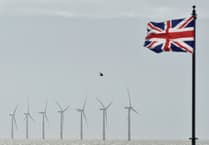Local authorities in Ceredigion, Powys and Gwynedd have seen a drop in carbon dioxide emissions since 2005, new figures show.
The data comes as a new report heavily criticises the government for a lack of action on climate change.
Greenhouse gas emissions are normally measured in kilotonnes of carbon dioxide equivalent (ktCO2e).
New figures from the Department for Energy Security and Net Zero show carbon dioxide emissions in Ceredigion have dropped 31.2 per cent from a total of 630 ktCO2e in 2005 – when data is first available – to 433 ktCO2e in 2021.
This was the equivalent of 6.1 tonnes of CO2 emitted per person in 2021.
In Powys they have dropped 32.2 per cent from 1,218 to 826 ktCO2e – the equivalent of 6.2 tonnes of CO2 emitted per person in 2021.
And in Gwynedd there was a 35.9 per cent decrease from 1,001 to 642 ktCO2e – equivalent to 5.5 tonnes of CO2 per person.
These figures cover emissions "within the scope of influence" of the local authority, meaning it excludes pollution from sources such as motorways and large industrial plants.
Sandra Bell, campaigner at Friends of the Earth, an environmental charity said: "There remains significant variation in how local authorities are performing on climate, and no council is getting everything right - nor will they until they are given more powers and funding from central government.
“National climate targets will not be met unless the government recognises the vital role that councils must play in working with communities to achieve transformative change."
Ms Bell urged for a council-led, street-by-street insulation programme to help drive emissions down.
The Local Government Association, which represents local authorities, has suggested a similar approach.
Cllr David Rodwell, the organisation's environment spokesperson, said councils are best placed to deliver on climate pledges.
He added councils need backing to "rapidly retrofit social and fuel poor homes, decarbonise transport, protect and grow biodiversity, and powers to roll out renewable energy schemes.”
The UK Government has committed to slashing emissions by 68 per cent by 2030, when compared to a 1990 baseline.
Local authority emissions across the UK have dropped 39 per cent since 2005, including a significant fall in 2020 at the height of the coronavirus pandemic.
However, they saw an 8 per cent increase between 2020 and 2021 as the UK came out of lockdown and economic activity resumed.
In Ceredigion, this meant a rise of 7.8 per cent from 402 ktCO2e in 2020; in Powys, an increase of 8.3 per cent from 762 ktCO2e; and in Gwynedd, a rise of 8.6 per cent from 591 ktCO2e.
A new report from the Committee for Climate Change – an independent advisory body – said government action on emissions is "worrying slow".
Chris Stark, the committee's chief executive, said: “There are no secrets for net zero any longer, we know how to do it.
“Right across the board we have well-worked-through strategies for how to cut carbon emissions to zero in most areas and for those sectors that we can’t get to absolute zero, we have enough capacity in the natural world and through more engineered solutions to take carbon out of the atmosphere.
He continued: “Those things take time. They need to put policies in place now that would steer us towards that future. That’s what we’re not seeing at the pace that’s required.”
Responding to the report, a UK Government spokesperson said: “The UK is cutting emissions faster than any other G7 country and attracted billions of investment into renewables, which now account for 40 per cent of our electricity.
“In the last year alone, we have confirmed the first state backing of a nuclear project in over 30 years and invested billions to kick-start new industries like carbon capture and floating offshore wind.”




